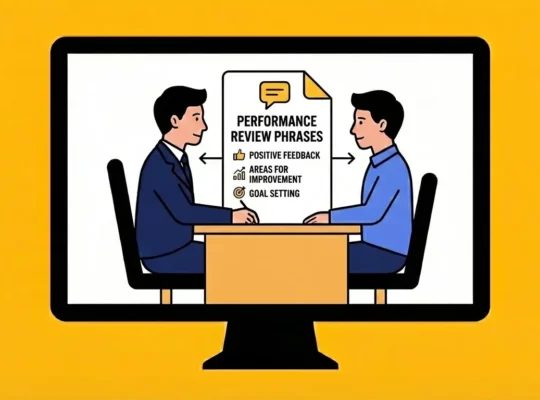Every company wants its employees to feel satisfied and engaged, but how can you truly measure these feelings? Enter the eNPS survey. Derived from the Net Promoter Score (NPS) used to gauge customer loyalty, eNPS (Employee Net Promoter Score) has become a game-changer in measuring employee sentiment. By asking one powerful question—”How likely are you to recommend your organization as a great place to work?”—companies can quickly assess employee loyalty and engagement. Simple yet effective, an eNPS survey offers businesses a fast, actionable insight into what their workforce thinks.
- What is eNPS?
- Why Should You Measure eNPS?
- How to Conduct an eNPS Survey? A 5 Step-Guide
- How to Calculate eNPS?
- What is a Good eNPS Score?
- Strategies to Improve Your eNPS
- Limitations of eNPS
- Overcoming Challenges in Measuring and Improving Engagement
- Best Practices for eNPS Surveys
- Additional Employee Engagement Metrics: A Holistic View
What is eNPS?
The Employee Net Promoter Score (eNPS) is a metric used to gauge employee satisfaction and engagement. It’s adapted from the Net Promoter Score (NPS), a measure often applied to customer satisfaction. eNPS is designed to assess how likely employees are to recommend their organization as a great place to work.
The foundation of the eNPS survey lies in a single key question: “How likely are you to recommend your organization as a place to work?” Employees respond on a scale from 0 to 10, and based on their scores, they fall into three categories:
- Promoters (9-10): Highly satisfied employees who are likely to advocate for the organization.
- Passives (7-8): Moderately satisfied employees who are neutral about recommending their company.
- Detractors (0-6): Unsatisfied employees who may negatively influence the organization’s reputation.
This simple yet effective question provides a powerful indicator of how employees perceive their workplace, which can directly influence a company’s culture, productivity, and ability to retain talent.
Why Should You Measure eNPS?
Measuring eNPS offers organizations a wealth of insights into the employee experience and satisfaction levels. It acts as a critical barometer, gauging whether employees feel engaged, valued, and motivated. But why is this so important?
Employee Satisfaction Impacts Performance
- Enhanced Productivity: Engaged employees are more productive, contributing to increased output and overall organizational success.
- Improved Quality: Engaged employees are more likely to care about the quality of their work, leading to better products and services.
- Reduced Errors: When employees are engaged, they are less likely to make mistakes and errors, improving efficiency and reducing costs.
Retention and Loyalty
- Reduced Turnover: Employees who are promoters (those who rate the company 9-10 on the eNPS scale) are significantly less likely to leave the organization. This reduces turnover costs and ensures a stable workforce.
- Positive Workplace Culture: Engaged employees create a positive and supportive work environment, attracting and retaining top talent.
- Brand Advocacy: Promoters are more likely to recommend the company to others, boosting its reputation and attracting new hires.
Real-Time Feedback for Actionable Insights
- Identify Pain Points: eNPS surveys provide real-time feedback, allowing organizations to quickly identify and address issues that are impacting employee satisfaction.
- Implement Improvements: By understanding employee concerns, organizations can take targeted actions to improve the workplace, boost engagement, and retain top talent.
- Continuous Improvement: Regular eNPS surveys enable organizations to track progress over time and make ongoing improvements to the employee experience.
How to Conduct an eNPS Survey? A 5 Step-Guide
eNPS surveys are a powerful tool for measuring employee engagement and satisfaction. To ensure you get the most valuable insights, follow these steps:
1. Design Your Survey
- Core Question: Start with the classic eNPS question: “How likely are you to recommend this organization as a great place to work?”
- Additional Questions: Consider adding open-ended questions to gather more detailed feedback on specific aspects of the employee experience.
2. Ensure Anonymity
- Reassure Employees: Clearly communicate that responses are confidential and will not be linked to individual employees. This encourages honest feedback.
3. Choose a Platform
- Popular Options: SurveyMonkey, Leapsome, BambooHR, and Typeform are popular platforms for administering eNPS surveys.
- Consider Your Needs: Select a platform that offers features like automated reminders, data analysis, and integration with other HR tools.
4. Encourage Participation
- Promote Internally: Use company communication channels to promote the survey and emphasize its importance.
- Set a Deadline: Provide a clear deadline to encourage timely participation.
- Offer Incentives: Consider offering incentives, such as raffle prizes, to boost participation rates.
5. Survey Frequency
- Regular Assessment: Conduct eNPS surveys regularly, such as quarterly or bi-annually, to track changes in employee satisfaction over time.
How to Calculate eNPS?
To calculate your eNPS, follow these simple steps:
- Identify Promoters, Detractors, and Passives:
- Promoters: Employees who rate your company 9-10 out of 10.
- Detractors: Employees who rate your company 0-6 out of 10.
- Passives: Employees who rate your company 7-8 out of 10.
- Calculate the Percentage: Determine the percentage of promoters and detractors in your workforce.
- Subtract the Detractors: Subtract the percentage of detractors from the percentage of promoters.
Example:
Promoters: 75%
Detractors: 10%
eNPS = 75% – 10% = 65
A positive score indicates that more employees are satisfied (promoters) than dissatisfied (detractors). A negative score suggests significant room for improvement. Here’s a table to make it clearer:
| Category | Percentage of Employees | eNPS Score Calculation |
| Promoters | 70% | |
| Detractors | 15% | |
| Final eNPS | 55 |
Interpreting eNPS Scores
- Positive eNPS (>0): Your organization has more promoters than detractors, which is a good sign.
- Neutral eNPS (0): You have an equal balance of promoters and detractors, signaling the need for improvement.
- Negative eNPS (<0): More detractors than promoters, indicating serious issues with employee engagement and satisfaction.
What is a Good eNPS Score?
A good eNPS score is relative to your industry and specific company context. While there are general benchmarks, it’s essential to focus on your organization’s unique circumstances and track your progress over time.
Here’s a breakdown of eNPS score ranges
- Above 50: Excellent – Indicates high employee satisfaction and loyalty.
- 30 to 50: Good – Shows a positive employee experience, but room for improvement exists.
- 0 to 29: Average – Suggests a mixed bag of employee sentiment.
- Below 0: Concerning – Points to significant issues with employee engagement and satisfaction.
Key Points to Remember
- Industry Benchmarks: Compare your eNPS score to industry benchmarks for a more accurate assessment.
- Internal Trends: Track your eNPS score over time to identify trends and measure progress.
- Focus on Improvement: Aim to increase your eNPS score continuously, rather than simply comparing it to others.
Strategies to Improve Your eNPS
eNPS is a powerful tool for measuring employee engagement and satisfaction. To improve your eNPS score and create a thriving workplace, focus on these key strategies:
1. Analyze Employee Feedback
- Uncover Insights: Dive deep into the feedback provided by your employees. Look for patterns, recurring themes, and areas of concern.
- Prioritize Issues: Identify the most pressing issues that are impacting employee satisfaction and engagement.
- Take Action: Develop targeted strategies to address these concerns and demonstrate a commitment to improving the employee experience.
2. Implement Actionable Changes
- Address Key Pain Points: Based on your analysis, take concrete steps to address the identified issues. This may involve adjusting workloads, improving communication, or implementing new policies and procedures.
- Communicate Progress: Keep employees informed about the actions you’re taking to address their concerns. This demonstrates your commitment to creating a positive work environment.
3. Conduct Deeper Surveys
- Explore Specific Areas: Use targeted surveys to delve deeper into specific areas of interest, such as leadership, compensation, or work-life balance.
- Uncover Hidden Issues: These surveys can reveal underlying problems that may not be apparent in the initial eNPS survey.
4. Foster a Culture of Continuous Improvement
- Regular Feedback: Conduct eNPS surveys regularly to track changes in employee satisfaction over time.
- Transparency: Be transparent about the results of your eNPS surveys and share your improvement plans.
- Employee Involvement: Encourage employees to participate in the improvement process by seeking their input through secure employee review management platforms.
Limitations of eNPS
While eNPS is a valuable tool, it’s essential to be aware of its limitations to get a comprehensive understanding of employee engagement.
1. Passives Excluded
- Incomplete Picture: Employees who score 7-8 on the eNPS scale are classified as passives and are not included in the final calculation. This can provide an incomplete picture of employee sentiment, as passives may still have valuable insights to share.
- Addressing Passives: To gain a more comprehensive understanding, consider conducting additional surveys or interviews with passive employees to uncover their specific concerns and needs.
2. Need for Supplementary Data
- Beyond the eNPS: While eNPS provides a high-level view of employee engagement, it’s essential to supplement it with other metrics and data sources.
- Employee Satisfaction Surveys: Conduct broader surveys to assess specific aspects of employee satisfaction, such as work-life balance, compensation, and career development.
- Qualitative Feedback: Gather qualitative feedback through open-ended questions, focus groups, or one-on-one interviews to gain deeper insights into employee experiences.
3. Single Question Limitation
- Nuanced Insights: The eNPS question, while effective, may not capture the full range of employee experiences and sentiments.
- Additional Metrics: Consider using other engagement metrics, such as employee net promoter score (eNPS), employee satisfaction surveys, and pulse surveys, to get a more complete picture.
Overcoming Challenges in Measuring and Improving Engagement
Measuring and improving employee engagement can be challenging, but it’s essential for organizational success. Here are some common obstacles and practical solutions to overcome them:
1. Resistance to Change
- Communicate the Benefits: Clearly articulate the benefits of employee engagement initiatives and how they align with the organization’s goals.
- Involve Employees: Foster a sense of ownership by involving employees in the design and implementation of engagement strategies.
- Gradual Implementation: Introduce changes gradually to minimize disruption and resistance.
2. Lack of Resources
- Prioritize Engagement: Allocate resources to employee engagement initiatives, recognizing their importance for long-term success.
- Leverage Existing Resources: Utilize existing HR tools and resources to support engagement efforts.
- Measure ROI: Demonstrate the return on investment of engagement initiatives to justify resource allocation.
3. Cultural Barriers
- Cultural Sensitivity: Be mindful of cultural differences and adapt strategies accordingly.
- Employee Input: Involve employees from diverse backgrounds in the design and implementation of engagement initiatives.
- Foster a Culture of Inclusion: Create a welcoming and inclusive environment where all employees feel valued and respected.
4. Measurement Challenges
- Choose the Right Metrics: Select engagement metrics that align with your organization’s specific goals and priorities.
- Regular Assessment: Conduct regular surveys and assessments to track changes in employee engagement over time.
- Analyze Data: Use data analytics tools to identify trends and patterns in employee feedback.
5. Lack of Leadership Support
- Executive Buy-In: Gain support from top leadership to ensure that engagement initiatives are prioritized and implemented effectively.
- Lead by Example: Encourage leaders to model positive behaviors and demonstrate their commitment to employee engagement.
Best Practices for eNPS Surveys
To maximize the value of your eNPS surveys, consider these best practices:
1. Ensure Anonymity
- Reassure Employees: Clearly communicate that responses are confidential and will not be linked to individual employees. This encourages honest feedback and builds trust.
2. Foster Transparency
- Explain the Purpose: Clearly articulate the goals of the survey and how the results will be used to improve the workplace.
- Share Results: Share the overall eNPS score and key findings with employees, demonstrating your commitment to transparency and accountability.
3. Take Action
- Identify Areas for Improvement: Analyze the survey results to identify areas where employee satisfaction is low.
- Develop Action Plans: Create targeted action plans to address the identified issues.
- Communicate Progress: Keep employees informed about the steps you’re taking to address their concerns.
4. Conduct Surveys Regularly
- Track Trends: Conduct eNPS surveys regularly to track changes in employee satisfaction over time.
- Identify Early Warning Signs: Regular surveys can help you identify potential issues before they escalate.
5. Supplement with Qualitative Feedback
- Gain Deeper Insights: Combine eNPS surveys with open-ended questions or focus groups to gather qualitative feedback. This can provide valuable context and help you understand the reasons behind your eNPS score.
By following these best practices, you can ensure that your eNPS surveys provide valuable insights and drive positive change within your organization.
Additional Employee Engagement Metrics: A Holistic View
While eNPS provides valuable insights, it’s essential to consider other key performance indicators (KPIs) to get a more comprehensive picture of employee engagement. Here are some additional metrics to track:
1. Absenteeism Rates
- Correlation with Engagement: High absenteeism rates can often indicate low employee engagement and job satisfaction.
- Track Trends: Monitor absenteeism rates over time to identify patterns and potential issues.
2. Turnover Rates
- Engagement Indicator: High turnover rates can be a sign of low employee engagement and dissatisfaction.
- Cost Analysis: Calculate the cost of turnover to understand the financial impact of disengaged employees.
3. Employee Satisfaction Surveys
- Targeted Feedback: Conduct regular employee satisfaction surveys to gather in-depth feedback on specific areas of the employee experience, such as work-life balance, compensation, and career development.
4. Employee Net Promoter Score (eNPS)
- Overall Engagement: While we’ve already discussed eNPS, it’s worth reiterating its importance as a key indicator of overall employee engagement and loyalty.
5. Employee Performance Metrics
- Productivity: Analyze productivity metrics to assess how employee engagement impacts performance.
- Quality: Evaluate the quality of work output to see if engagement correlates with improved performance.
Employee engagement is a critical factor in organizational success. By measuring employee satisfaction and loyalty through eNPS surveys, companies can gain valuable insights into their workforce and take targeted actions to improve the workplace. At Review.jobs, we know that regularly gathering and acting on employee feedback can transform organizations. By implementing an eNPS survey, companies can unlock insights that drive a more engaged, satisfied workforce—leading to a better workplace for everyone.





